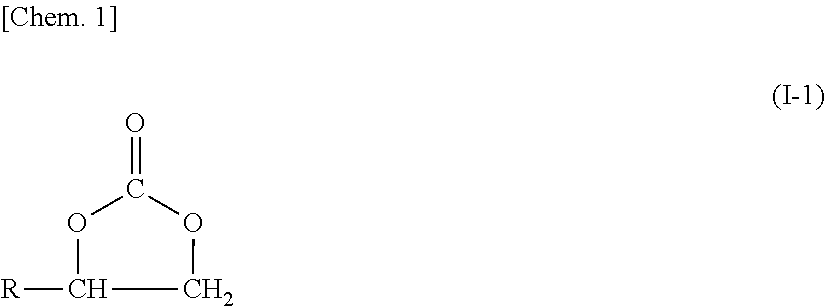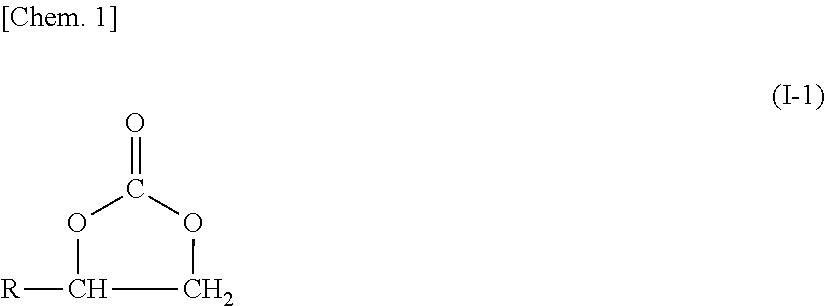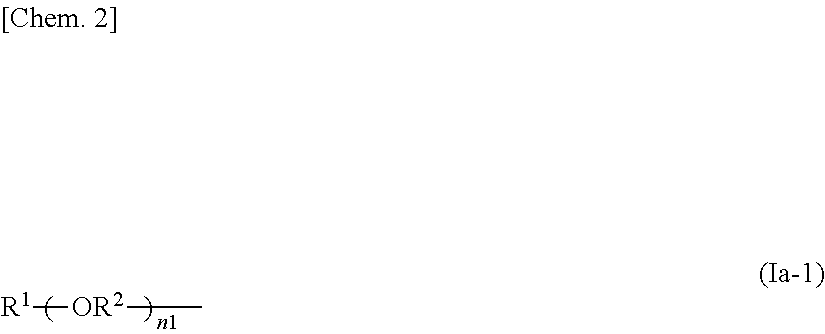Electrolytic solution
- Summary
- Abstract
- Description
- Claims
- Application Information
AI Technical Summary
Benefits of technology
Problems solved by technology
Method used
Image
Examples
synthesis example 1
Synthesis of 4-(2,2,3,3-tetrafluoropropoxymethyl)-(1,3)-dioxolan-2-one (I-1a)
[0187]A 100 mL autoclave made of stainless steel was charged with 40 g (212 mmol) of
[0188], 350.0 mg (4.03 mmol) of LiBr, and 40 ml of N-methylpyrrolidone (NMP), and the interior of the autoclave was evacuated under stirring. Next, CO2 corresponding to 1 MPa at room temperature was added to the system, and the reaction was initiated by raising the temperature in the system to 100° C. The pressure dropped as the reaction progressed, and hence CO2 was further added until the system pressure stabilized at 1 MPa. Once the system pressure stabilized, the system temperature was reverted to room temperature, to terminate the reaction. The obtained reaction solution was added to a 1N-HCl aqueous solution.
[0189]The obtained bottom layer was distilled under reduced pressure (2 mmHg), to yield a fluorine-containing ether cyclic carbonate as the fraction at 133° C.
synthesis example 2
Synthesis of (I-1b):4-(2,2,2-trifluoroethoxymethyl)-(1,3)-dioxolan-2-one
[0190]A 100 mL autoclave made of stainless steel was charged with 33.1 g (212 mmol) of
[0191], 350.0 mg (4.03 mmol) of LiBr, and 40 ml of N-methylpyrrolidone (NMP), and the interior of the autoclave was evacuated under stirring. Next, CO2 corresponding to 1 MPa at room temperature was added to the system, and the reaction was initiated by raising the temperature in the system to 100° C. The pressure dropped as the reaction progressed, and hence CO2 was further added until the system pressure stabilized at 1 MPa. Once the system pressure stabilized, the system temperature was reverted to room temperature, to terminate the reaction. The obtained reaction solution was added to a 1N-HCl aqueous solution.
[0192]The obtained bottom layer was distilled under reduced pressure (2 mmHg), to yield a fluorine-containing ether cyclic carbonate as the fraction at 130° C.
synthesis example 3
Synthesis of (I-1c)
[0193]A 100 mL autoclave made of stainless steel was charged with 33.1 g (212 mmol) of
[0194], 350.0 mg (4.03 mmol) of LiBr, and 40 ml of N-methylpyrrolidone (NMP), and the interior of the autoclave was evacuated under stirring. Next, CO2 corresponding to 1 MPa at room temperature was added to the system, and the reaction was initiated by raising the temperature in the system to 100° C. The pressure dropped as the reaction progressed, and hence CO2 was further added until the system pressure stabilized at 1 MPa. Once the system pressure stabilized, the system temperature was reverted to room temperature, to terminate the reaction. The obtained reaction solution was added to a 1N-HCl aqueous solution.
[0195]The obtained bottom layer was distilled under reduced pressure (2 mmHg), to yield a fluorine-containing alkyl cyclic carbonate.
PUM
 Login to View More
Login to View More Abstract
Description
Claims
Application Information
 Login to View More
Login to View More - R&D
- Intellectual Property
- Life Sciences
- Materials
- Tech Scout
- Unparalleled Data Quality
- Higher Quality Content
- 60% Fewer Hallucinations
Browse by: Latest US Patents, China's latest patents, Technical Efficacy Thesaurus, Application Domain, Technology Topic, Popular Technical Reports.
© 2025 PatSnap. All rights reserved.Legal|Privacy policy|Modern Slavery Act Transparency Statement|Sitemap|About US| Contact US: help@patsnap.com



